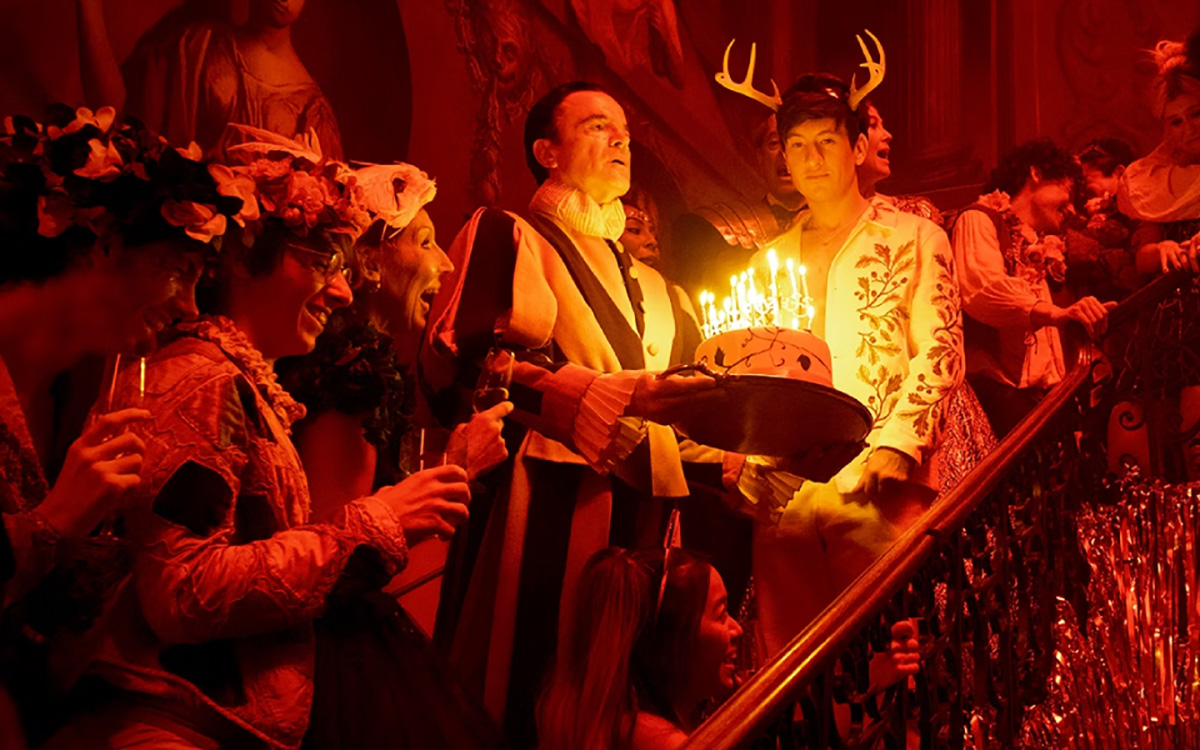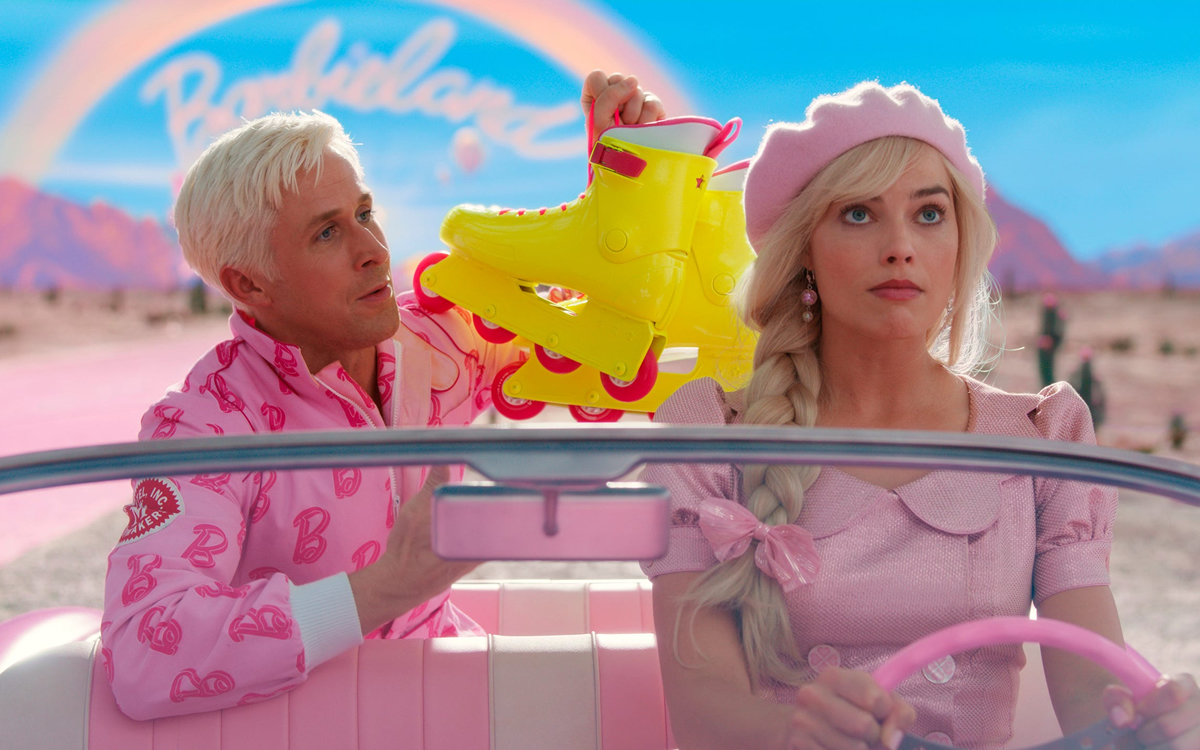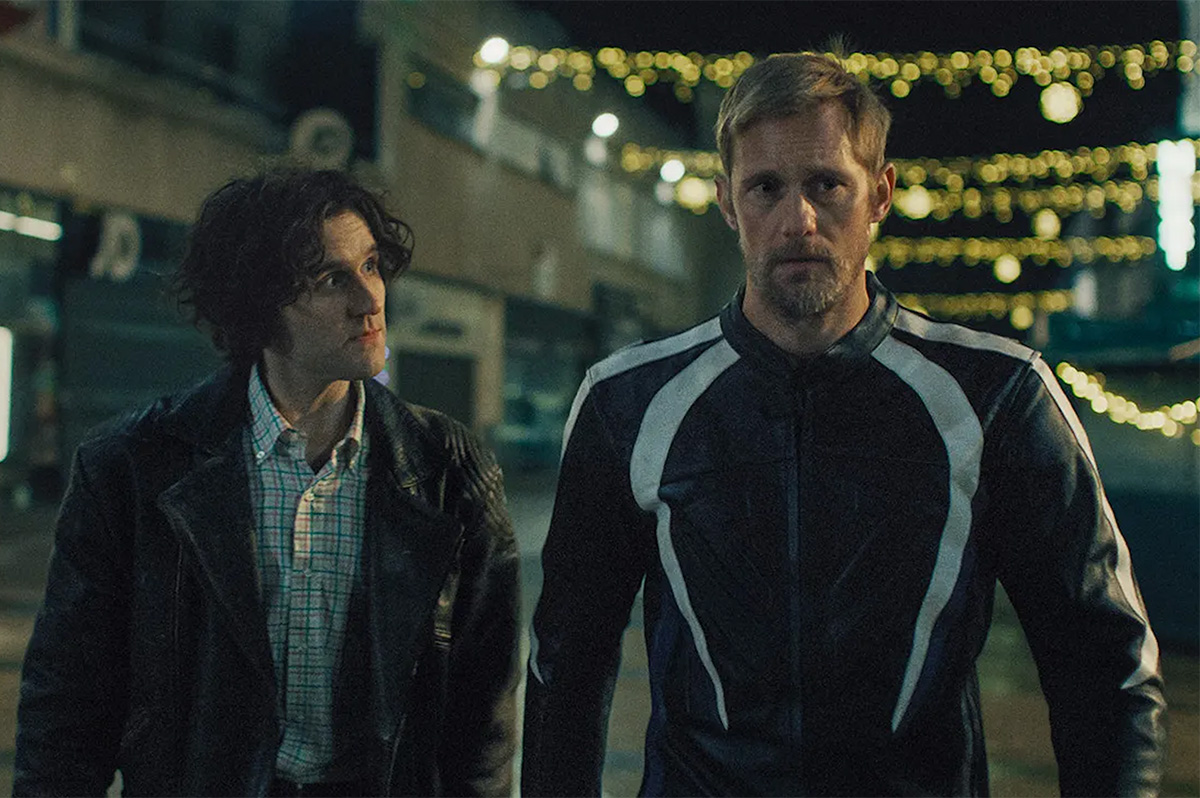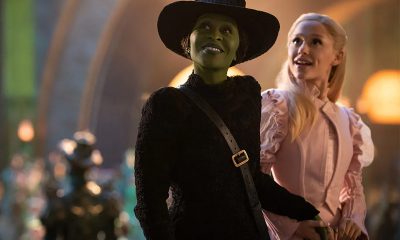Movies
The top 10 queer-centric movies of 2023
From ‘Rustin’ to ‘Barbie,’ it was a banner year in cinema

It’s been a great year for movies, we’re glad to say, but that’s made it harder than usual for us to compile our annual list of the 10 best queer-centric films. Still, we’ve made the hard calls necessary, and come up with our picks for the most outstanding of all the movies we’ve covered over the last 12 months.
You all know how these things work, so we won’t waste space with unnecessary explanations. Here, listed in reverse order, are the Blade’s Top Ten Films of 2023:
10. Rustin (Dir: George C. Wolfe)
Biopics face a difficult challenge when it comes to presenting an authentic portrayal of their subject: How do you encapsulate a person’s life into a two-hour story without relying on broad strokes? This frank and inspiring look at Civil Rights hero Bayard Rustin, whose monumental contribution to the movement was all-but-unsung for decades thanks to his open homosexuality, skirts the usual pitfalls by focusing on a specific episode in his career-orchestrating the 1963 March on Washington where MLK delivered his culture-shifting “I Have a Dream” speech – and delivering a behind-the-scenes snapshot of a seminal moment in American history at a time when stories about the triumph of activism feel more urgent than ever. Even so, it makes it onto our list mainly on the strength of star Colman Domingo, whose unapologetically thorny interpretation of the late queer icon is an engrossing – and refreshingly un-romanticized – powerhouse from start to finish.
9. Of An Age (Dir: Goran Stolevski)
What yearly “Best of” list would be complete without one or two under-the-radar gems? This Australian import (made in 2022, but released in the U.S. early this year) qualifies on both counts, but more importantly it’s a reminder that – despite frequent complaints to the contrary – there are great queer romance movies being made. This one is about two teens (Elias Anton and Thom Green) who spend a day together and fall hard for each other, but time and circumstance are not on their side; years later, reunited at a wedding, they find the connection between them has endured, but it may be too late to do anything about it. It’s a simple premise, and not much happens in terms of plot, but the winning authenticity of the love story it tells – and the way it captures unresolvable longing – is infinitely and universally relatable. It’s not a gay love story, it’s a love story between two people who happen to be gay, and that makes all the difference.
8. Rotting in the Sun (Dir: Sebastian Silva)
Even more under-the-radar, perhaps, is this out-of-left-field contender from out Chilean-born filmmaker Silva, who casts himself and real-life social media star Jordan Firstman as fictional versions of themselves in an outrageous, interwoven stream-of-events narrative that savagely satirizes the perpetually distracted state of self-obsessed modern culture while offering a darkly humorous commentary on cultural classism. It’s a lot to juggle in a single movie, but Silva pulls it off audaciously in a movie that does not go where you expect it to go and defies easy categorization by blending absurd farce with heartrending tragedy without missing a single beat. It also features un-simulated queer sex, and the fact that bold move is not the main attraction is itself testament to the power of this film’s unique vision. An MVP performance by veteran Chilean actress Catalina Saavedra is the richly satisfying icing on the cake.
7. Asteroid City (Dir: Wes Anderson)
This might be a controversial choice for us, given that critical response for this quintessentially Wes-Anderson-y think piece has been sharply divided and that the “queer factor” involved is relatively low; nevertheless, we stand by it, and only partly because the existential summer of “Barbenheimer” (more on that later) began with the quirky cult filmmaker’s visually stunning fantasia about a gathering of disparate characters in a kitschy New Mexican town for a government-sponsored “young inventors” competition during the height of 1950s-era “nuclear panic.” True to form, Anderson places meta-layers upon meta-layers by framing his narrative as a real-life theatrical play – penned by a queer playwright (Edward Norton) having a love affair with his leading man (Jason Schwartzman) – being memorialized in a TV documentary. And while this might make it hard for some to keep track of the story or identify with the characters, it also makes this movie into an almost perfect meditation on the way a cultural “zeitgeist” – in this case, the percolating dread that dominated world consciousness in the aftermath of the atomic bomb – manifests itself in our shared public imagination. An all-star cast of players (including Scarlett Johannson, Tom Hanks, Tilda Swinton and a host of others) only sweetens the pot.
6. May December (Dir: Todd Haynes)
It may be no surprise to see the latest film by “new queer cinema” icon Haynes on our list, but rest assured we’re not the only ones to recognize the brilliance of this uncomfortable character study in which a Hollywood actress (Natalie Portman), hired to star in a docudrama about a real-life tabloid sex scandal involving the inappropriate relationship and subsequent marriage between an adult woman (Julianne Moore) and an underage boy, descends on the couple’s household, stirring up long-unaddressed feelings for each of them as she loses herself in the persona of her role. Steeped in the tranquilizing suburban blandness that has always been a hallmark of Haynes’ melancholy, subversively divergent milieu, it’s the kind of movie that feels like a fever dream and leaves you grappling with issues you thought you’d worked out for yourself years ago – and while Portman and longtime Haynes muse Moore both deliver their usual stellar performances, it’s Charles Melton’s unexpectedly nuanced turn as the now-adult object of Moore’s transgressive desires that provides its troubled heart.
5. Oppenheimer (Dir: Christopher Nolan)
OK, there’s not really a specific queer angle to this introspective, epic-length film about the man who built the atom bomb, but the themes and questions it forces us to confront – all tied to the looming specter of effectively instant worldwide annihilation we’ve been living with ever since the nuclear blasts that brought WWII to an abrupt and sobering end – make it essential viewing anyway. Centered on the white-knuckle intensity of Cillian Murphy’s performance in the title role and bolstered by equally invested work from an all-star ensemble of supporting players (Emily Blunt, Robert Downey, Jr., Matt Damon, and more), Nolan’s finely wrought biopic becomes a meditation on responsibility, blame, the madness of mutually assured destruction, and – most significantly of all – living with an omnipresent sense of inevitable doom. Yet as depressing as all that sounds, the film resonates with enough humanity and compassion – even for its most ethically challenging characters – that we can walk away from it with something that feels almost like hope.
4. All of Us Strangers (Dir: Andrew Haigh)
Invading our list from the UK is the latest film from the writer/director who raised the bar for queer romance movies with 2011’s “Weekend,” a haunted (literally) love story in which a lonely London screenwriter (Andrew Scott) communes with the ghosts of his long-deceased parents (Claire Foy, Jaime Bell) while beginning a tentative relationship with a handsome but palpably sad neighbor (Paul Mescal). Based on a novel by Japanese author Taichi Yamada, it’s a ghostly tale more esoteric than supernatural, driven by mood, draped in primary colors, and infused with life through the tenderness between its two fragile lovers, less interested in the details of a hypothetical afterlife than it is in the bonds of love – in all its forms – which connect us to each other beyond time and mortality. Sure, it’s gloomy on the surface, and it brushes up against sorrows that are mercifully unfathomable to many of us, but it somehow manages to leave us uplifted rather than unsettled – and almost as a bonus, the sweet-and-sexy chemistry between its leading men will stick with you long after the final credits roll.
3. Saltburn (Dir: Emerald Fennell)
We’re not going to lie: part of what earns this gnarly, aggressively twisted movie a high place on our list is its audaciousness. In its tale of Oliver Quick (Barry Keoghan), a working class lad on scholarship to Oxford whose infatuation with a charismatic and wealthy classmate (Jacob Elordi) leads to a debauched and treacherous summer at the elegantly dilapidated country estate of the title, it turns a vaguely Dickensian story of fate, irony, and social commentary into an escalating wild ride that takes us places we don’t expect to go and never wanted to see, and it makes us love every guilty second of it. Yes, it’s dark and depraved, an over-the-top, starkly satirical look into the casually cruel world of the “ruling class” that forces us to ask just how far we would be willing to go to become a part of it, and it uses our own expectations against us to deliver a bombshell ending that might feel like a slap in the face for those who aren’t paying close attention (and possibly for those who are, too) – but all of that gives us even more reason to laud this second effort from the daring writer/director of “Promising Young Woman” as one of the most thrilling and unforgettable cinematic experiences of the year.
2. Killers of the Flower Moon (Dir: Martin Scorsese)
Like “Oppenheimer,” there’s no direct queer thread to be found in this late-career masterpiece from one of America’s most accomplished cinema artists, but its exploration of the deeply embedded racism that has been woven throughout our nation’s history has obvious resonance for anyone whose status as an “other” places them at risk of exploitation, oppression, and worse in a culture that is stacked against them. Based on the non-fiction book by David Gann, it chronicles a conspiracy in 1920s Oklahoma in which the indigenous Osage community, made rich by the oil fields under its tribal land, was robbed of its wealth by local white business leaders through a systematic campaign of marriage and murder, and the efforts of the then-fledgling FBI to bring the perpetrators to some kind of justice. With career-highlight performances from Leonardo DiCaprio and Robert DeNiro, as well as a revelatory turn from indigenous actor Lily Gladstone, there’s more than enough great acting to keep us mesmerized throughout its three-and-a-half-hour runtime – and the same understanding of the pathology of corruption that Scorsese deployed in his classic sagas about organized crime breathes powerful insight into a story that has just as much to say about the America we live in today as the one in which it takes place.
1. Barbie (Dir: Greta Gerwig)
When we first predicted this would be the movie of the year, our tongue may have been firmly planted in our cheek – but we’re not sorry to be able to say we were right. Not just a campy fantasy about a doll, it’s a truth bomb delivered in a candy-colored Trojan Horse, in which an unexpected existential crisis (do we detect a running theme in this year’s movies?) sends Barbie (Margot Robbie) into the human world looking for answers and ends up turning her own world upside down as Ken (Ryan Gosling), having seen the glories of “the patriarchy”, tries to remake Barbieland in his own image. It’s a premise that gives Gerwig (and partner Noah Baumbach, with whom she co-wrote the screenplay) plenty of fodder to skewer contemporary culture, and she takes aim at all the usual targets as she gleefully spreads the kind of progressive, humanitarian, pro-feminist, socially ethical messaging that conservative pundits like to fall over themselves dismissing as “woke” propaganda. But that’s not the endgame in this transcendent wonder of a movie, because Gerwig and company take things beyond the dualistic dogmas that stymie us in our quest for a more equitable world to ask some much deeper questions, creating a piece of absurdist cinema with as much intellectual weight as any film you’re ever likely to see. Of course, viewers hung up on the “culture war” talking points being batted around from every direction might not notice, any more than they are likely to notice the comprehensive array of nods and tributes she pays along the way to the iconic movies that inspired her, but one of the many joys of “Barbie” is that it reveals more with each repeat viewing – so there’s always hope they’ll catch on, eventually.
Oh, and even if the only queer content it contains comes in the form of deliciously unsubtle innuendo, there’s something quintessentially queer about it – and we’re not just talking about the color palette.

Movies
Long-awaited ‘Pillion’ surpasses the sexy buzz
A film to admire from a promising new queer director

In case you didn’t know, “Pillion” – the title of debut UK filmmaker Harry Lighton’s buzzy gay “fetish rom-com” starring Scandinavian hunk Alexander Skarsgård and “Harry Potter” alumnus Harry Melling – refers to a rear seat on a motorcycle for a passenger, and the person who occupies it is said to be “riding pillion.”
That definition might be useful going into the movie’s story of an introverted gay Londoner who becomes involved with a handsome but icy biker and is introduced to the subculture of Dom/sub relationships, in that it evokes a dynamic that might be said to reflect the one that exists between its two main characters. There is nothing about Lighton’s disarmingly humorous and surprisingly sweet film, however, that seems to imply an interest in offering pat explanations or easy value judgments about the lifestyle it explores, so to think its title is meant as some kind of summation would be a mistake.
It centers on Colin (Melling), a timid parking warden who still lives with his mom and dad (Lesley Sharp and Douglas Hodge) and sings with a barbershop quartet as a hobby. After a gig singing Christmas carols at a gay bar, he catches the eye of sleekly confident Ray (Skarsgård), who gives him his phone number after a brief and thrillingly intimidating interaction. Prompted by his parents, he decides to call, leading to a steamy hookup in a back alley – and eventually, a live-in BDSM situation in which he becomes Ray’s official “sub,” catering to his every need and becoming a member of the gay biker community to which he belongs. It’s all perfectly fine with Colin, who embraces his role with pleasure; but when he begins to long for a deeper connection with the enigmatic and emotionally distant Ray, it triggers a disruption in the dynamic of their relationship, putting it to a test it may not be able to pass.
“Pillion” was already creating a stir before its prize-winning debut at the Cannes Film Festival last May, largely thanks to the highly publicized casting of Skarsgård as the leather-clad leading man in a gay BDSM romance. But near-universal critical acclaim quickly validated the buzz, turning it into one of 2025’s most anticipated movie releases – particularly, of course, for gay audiences, and especially for those who are part of the BDSM community and rarely get the opportunity to be “seen” on the screen as anything other than a lazy stereotype.
Naturally, much of that buzz has been driven by a prurient fervor, fueled by the promise of kinky onscreen sex and rumors of a notorious close-up highlighting the full-frontal assets of a certain Swedish movie star. One of the things that’s remarkable about “Pillion,” however, is that while it certainly doesn’t downplay the overt sexual aspect of the relationship at its center, it doesn’t use them to titillate or shock us. Its plentiful scenes of intimacy are sexy, yes, but they also chart the development of the characters’ bond together, expressing feelings that can only be left unspoken within their agreed-on dynamic. They advance both the story and our awareness of the characters’ psychology, and while they may occasionally provide a jolt for viewers not accustomed to seeing gay fetish sex portrayed explicitly on screen, they successfully capture the joy of the experience instead of making it feel sensationalized or lurid.
In fact, once “Pillion” ends, it’s not the sex (not exclusively, at least) that lingers in our mind; it’s the delicate balance it maintains between tension and ease, detachment and tenderness, rigidity and flow – mirroring the surging passions contained within the strictly regimented order of their power dynamic. It’s the depth of Melling’s film-anchoring performance, in which he undergoes an entire voyage of discovery that emphasizes Colin’s strength, not his timidity, and allows us to relate to him in ways that may surprise us. It’s the authenticity of the relationships between all the characters, from Sharp and Hodge’s doting parents to Scissor Sisters front man Jake Shears (in his film acting debut) as a fellow sub who ignites a spark of jealousy between Colin and Ray; most of all, it’s the way that it allows the story to move, with a slow and methodical rhythm – reflected in the measured strains of Eric Satie’s “Gymnopode No.1” that echo through Oliver Coates’ evocative score – that makes it all feel perfectly natural.
And yes, it’s also the presence of Skarsgård, who subtly (and with wry humor) contrasts tight-lipped alpha stoicism with his flawless male beauty that feels like a force of nature. We don’t know much about Ray, ever, through the dialogue in Lighton’s tersely worded screenplay, but we can draw our own conclusions from the eloquent silence that Skarsgård wraps around the character like a security blanket. Best of all, he never uses his “Dom” role in the film to overshadow Melling – it’s Colin’s story, after all, and Skarsgård’s Ray deploys a tactic of “quiet command” on him throughout without ever stealing his spotlight.
As for the film’s writer/director, Lighton manages perhaps the most delicate balancing act of all. He takes a story (adapted from a novel by Adam Mars-Jones) about someone discovering himself in the BDSM community, who engages in sexual behavior that’s likely out of the comfort zone of many viewers and enters a “romantic” partnership most people would find unacceptable, and turns it into a movie that is all about the complexities of human experience. You may not know much (or want to) about life as a sub in a BDSM partnership, but you know what it feels like to love someone, and to long for love in return; Lighton understands that “Pillion” is a story about that, and he knows how to tell it so that you will understand it, too.
That said, it’s obvious there will be many audiences out there for whom a movie about leather-clad queer fetish sex might simply be a step too far for them to take. Anyone approaching “Pillion” should be aware that, depending on your own level of familiarity – or comfort – with the BDSM lifestyle, your reaction may vary across a spectrum of perspectives; if you’ve been around it, nothing the movie shows you is likely to ruffle your feathers, and if you haven’t, well, only you know your limits.
For us, it’s a film to admire from a promising new queer director, shining a light on an insular culture within the larger rainbow community with intelligence, dignity, and a refreshing lack of the homophobic tropes that so often haunt queer movies, even when they are made by queer filmmakers themselves.
Unfortunately for Americans, while “Pillion” was released in the UK on Nov. 28, we won’t get a chance to see it until Feb. 6. With the buzz now even stronger and the stars in full “promotional” mode on the talk show circuit, we thought it would be a good idea to let you know that the wait might still be a while, but it will be worth it.
After all, as any good Dom can tell you, a pleasure withheld tastes even sweeter when it’s finally given.

What does longing for your child look like? What happens when they resurface in front of you, when that rift was once an immeasurable open sea — a searing pain that silently hollowed you out for decades? For the child wrenched away by circumstance and thrown into the purgatory of always feeling in-between: in between home, in between being a whole person, in between who you could have been and who you are now — what does it mean to become and belong?
In filmmaker Jota Mun’s documentary “Between Goodbyes”, the fragmented yearning for home, family and identity are woven together into a tremendous and at times dream-like contemplation of the self, focused on various family members set adrift by a deceitful international adoption machine.
The story is focused on Mieke Murkes, a queer Korean adoptee who grew up in the rural village of Vaassen in the Netherlands. Shortly after her birth in 1982, she was raised by Willy, a devout evangelical Christian woman. But the story does not begin with Mieke in Vaassen. It begins with Okgyun, her original mother, walking through an ephemeral meadow as she makes her way to a shoreline. This is our first point of loss.
It is important to understand how the stories of Okgyun and Mieke exist. In “Between Goodbyes”, we see a frustrating glimpse into the cultural and political forces that created this separation. Since 1955, 200,000 children have been adopted from South Korea, and just three years ago, several of these adoptees found that their documents had been falsified. Murkes would sift through her own papers in “Between Goodbyes”, noting their dull and rote descriptions of her physical appearance and health. “The paperwork is as if you’re buying a new car,” Murkes says.
Written nearby: “Both parents are unknown,” a falsehood that leaves the family breathless. It is a gut punch.
This March, a South Korean governmental agency admitted that it had violated the rights of adoptees, but an investigation that began in 2022 at the behest of over 350 Korean adoptees has been halted. Whether or not retribution can ever be paid is up in the air, but the reeling grief and complicated self-reckoning many of these adoptees and their families face are rendered and expressed with deep tenderness in Mun’s documentary. “I did not know how to fit the Korean part of me in there,” Murkes said.
When Okgyun was pregnant with Mieke, she was also raising three other daughters: Mijin, Mikyung and Taekyung. The population was booming, and mothers like herself were being shamed for continuing to have children. Considering abortion, Okgyun recounts a midwife who convinced her not to go through with it — that if the child were a boy, she should keep him. If it turned out to be a girl, she could give her away to live “a good life” in the U.S. “Men are always positioned above women,” Okgyun said. “I always hated that.”
After Mieke was born, Okgyun’s mother-in-law told her to give her away. “She was gone before I saw her face,” Okgyun said. “I let her go.” Her guilt tightens her throat, trembles in her voice. “I dreamed of Mieke a lot. I can’t tell you how many times,” Okgyun said. “Dreaming and forgetting, dreaming, and forgetting. The thought that kept me going is that one day I can find Mieke.”
What ensued was a several years-long search. Kwangho, Mieke’s original father, pleaded with an adoption agency for any leads about Mieke. They denied him several times and his desperation only grew. “I had to find her to be at peace before I die,” he said.
Meanwhile, Mieke’s own grief and confusion were compounding. When she was beginning to discover her queerness, she was deeply ingrained in local religious spaces. What made her feel free, the church treated as an aberration — as behavior that resulted from loss.
When she would eventually meet her original family, they, too, had trouble processing her queer identity and masculine presentation. To them, queerness was “acquired” from being raised in a foreign land. With time, they grew to embrace Mieke and her partner, Marit, even as misunderstandings arose. Of this, Mieke’s conflictedness is explored. Gay rights are more advanced and accepted in the Netherlands than in South Korea, but this does not mean contending with her queerness would have been easy with her adoptive mother, Willy. “It probably would have disappointed her a lot,” Mieke tearfully revealed.
Mieke’s stepping in between knowing and unknowing is reminiscent of Okgyun’s dreaming and forgetting — their grief and confusion move within them, replicating themselves over and over again. “Between Goodbyes” dives deeply into this in order to offer a portrait of healing: of its complications and the necessity of community support to achieve this.
Mun discusses the film with the Los Angeles Blade, diving into how reunification between adoptees and original family members is, in many ways, made nearly impossible by factors like language and cultural barriers enforced and held tightly in place by the international adoption system. This film illustrates a break in this narrative and the mighty efforts behind it all.
A broadcast version of “Between Goodbyes” is now available to stream on PBS. See below for more information.
Can you tell me about the inception of making “Between Goodbyes”? Have you always wanted to tell a story about international Korean adoption from a queer perspective?
As a queer Korean adoptee myself, [there are] so many intersections that I haven’t quite seen on screen before. So I was always really excited about making something about my community. And then I’d say, in 2017, is around when I started getting closer to zeroing in on the idea. I think part of it was through befriending Mieke and hearing her parents’ story. Hearing about their efforts really blew my mind.
So much of the standard narrative is that adoptees initiate the search. So even before meeting [Okgyun and Kwangho], it just felt like it spoke so loudly of not only their character, but a piece of the puzzle that I had never considered — that they could be longing for us. And I think as an adoptee, you always wonder what [your original parents] would think. So it’s very noticeable that we almost don’t ever hear from them directly. Even in narrative stories of adoption, they’re usually deleted, or they’re written in a really flat way that feels like they’re serving the plot. I’ve never seen a depiction of birth mothers in particular who are questioning their own circumstances or feel angry about it.
There’s a lot of nuance given to all of the different people that we see in the story. The pain is layered and deep, and we don’t just view it from one perspective. What was it like having to portray this hurt, when many adoption stories typically focus solely on the adoptee’s emotional and personal journey?
It’s so unique through each lens, even though it’s the same pain. Like her sisters — of course, it’s going to affect them. Even if she never said anything, they must have felt it. It just ripples out to everyone and keeps expanding.
Originally, it was focused on Mieke, because that’s who I had the most access to, and she’s the closest to me in terms of general identity markers. So in my mind, I felt more confident that I could tell her story in a nuanced way. But what about Okgyun? I was hitting a similar barrier of communication that Mieke had hit. That’s part of why our main producer, Zoe Sua Cho, was so essential in conveying more about Okygun and the original family’s side of the story.
When I was in the early stages of developing the film, there was a quote that I felt was really inspirational: “In our hurting, we did not realize that we were stolen from each other” (by SN Désirée Cha from Outsiders Within Writing on Transracial Adoption.) The same quote came back to me in the edit and helped us find a narrative structure that went beyond just one person’s perspective.
What if the main character is the collective trauma, a singular event that causes the family to splinter and suffer across decades? I wanted to explore how tempting it is in these moments of righteous anger at systemic problems to end up fighting with each other. I feel like they both had to mourn something that was so much bigger than any one family. Mieke’s adoption affected so many people that I almost wanted that to be the main character. How do we not get lost in that pain and still try to come back together? It’s too much to carry alone.
So the main character is not necessarily one person, but the issue that you’re trying to tackle throughout the story. It also makes me think about how the documentary itself, or the making of it, also participates in this community healing that I feel like was the focus of “Between Goodbyes”.
I hope it’s an important layer. Suffice to say I think I always deflect to name a singular main character. I wanted to show everyone’s point of view while of course highlighting especially Okgyun and Mieke.
What else can you share about your approach to filmmaking?
You know, I was on this wonderful panel earlier this year, hosted by A-DOC, and I kind of surprised myself in preparing for it. I realized, actually, I have a lot of strong beliefs on filmmaking ethics that I hope come through in the film. For example, I reject the genius artist myth. The fantasy that if an artist is talented enough, they get permission to treat everyone around them terribly. That exploitation and squeezing things out of people is the best way to make great art.
Instead, I want to believe that the sensitivity, the care, and emotional work I poured in is going to come shining through in the film. And I do think that’s part of why we witnessed so many intensely vulnerable moments that I couldn’t have predicted.
This emotional connection to the film is also, visually, represented in artistic and inventive ways. There are sequences interspersed throughout that feel dream-like and cinematic. Creatively, what was it like to structure and craft how you wanted those scenes to be, the weight that they carried, and why you wanted to represent them in that way?
Aw, thanks for saying so! I was clear from the beginning that I wanted certain moments in the film to look as cinematic and epically life-changing as they feel in real life. Because visually, sometimes these moments of heartbreak can look rather dull. The deep heartbreak of a farewell at the airport. What does it look like? It looks like two people hugging in a very normal-looking terminal. But that’s not what it feels like. It feels larger than life. So to me, every single one of the art [scenes] has a very literal symbolism in my mind.
I really enjoy the complexity given to the family, both through the artistic symbolism and through the different angles we get to view them in. When it comes to Mieke’s queer identity, there are varying levels of acceptance and also tension that co-exist. One of her sisters, Mikyung, skirts around terms and labels, instead saying Mieke is “like that,” and “I don’t know anyone like that.” There was this feeling that queerness is learned or acquired elsewhere — that Mieke “wouldn’t have turned out like that” if she had grown up with her original family in Korea.
I can’t be sure what they were implying but you know, I definitely didn’t want to fall into a common trope of seeing Western values as being so liberal and accepting and framing all other cultures as homophobic. I want to be clear that there is a queer community in Seoul. It’s not the same as Amsterdam, of course, but it does exist.
That’s part of why it was important for me to include Mieke mentioned what she thinks her Dutch mom would have thought — just to clarify that homophobes are everywhere. There are plenty of them here in the West as well. Mieke’s Dutch parents were Evangelist Christians. So it’s not like everyone in the West is free to be a lesbian, you know?
Another moment that struck me in the film was a moment where we, as the audience, get to see you clearly. In this scene, we see you and Mieke on a rooftop, and you’re consoling her as she’s trying to prepare for a difficult conversation with her original mother, Okgyun. Did you have to find a balance in terms of being the director of this film and being Mieke’s friend?
It was really important to me to show friendship and how much that can help you along the journey. You think that for her to emotionally process things, it would have to be with her mom. But that rooftop conversation felt so transformative in itself. And then what ended up being the kind of mirror scene to that was Okgyun talking to Ruth [a fellow original mother]. She needed a buddy, too. How many times in life are we like: the opposing party doesn’t need to get it, but if my friend just could — that would give me so much relief and patience to enter the actual conversation with the person I’m upset with.
Being so personally close to Mieke and her family meant that my film was about all people I loved and cared about. I think the documentary field comes from such a long history of an anthropological approach. It’s like, “I’ve helicoptered in, and I just met you, but I’m the expert artist.” I wish the ethos were the opposite; we need to care about everyone, from the participants to the crew. I don’t want the blood, sweat, and tears to come through on the screen. I hope that watching it makes people feel cloaked in tenderness and care.
I was so worried about everyone, probably too much. It’s such a weird thing to ask people to do, to be in a film, so I took that with a lot of responsibility. Be aware of the impact you’re having. I am having an effect on this family’s life. I almost wanted to be like: “Forget my art project.” This is about the rest of their lives as a family, and that’s more important. So it became a light on my path, trying to make decisions as best I could to have a positive impact on their relationship.
It almost made me question my ethics in a different direction. “Am I intervening too much?” And that’s a strange thing: I have to admit I exist. I’m not a fly on the wall. And I think that’s why the conversation on the roof was really the most vulnerable for me, because I was showing myself. I’ve actually been here the whole time, cheering them on or trying to diffuse tension. I set out to make a film about how hard it is to stay in reunion, but now I’ve realized I’ll be heartbroken if their reunion doesn’t last. So in many ways the film was really just a vehicle for my attempt at keeping us all connected across so many distances, and that’s my own emotional journey or connection to their story.
Mun plans to release the full-length film in 2026, along with deleted scenes and additional footage. Up-to-date information can be found on the film’s Instagram page.
Movies
A bad romance is brought to light in ‘300 Letters’
All is not as it seems on social media in gay ‘anti-romcom’

We’ve all known them. We’ve all watched those couples on our “friends” feed who seem to live a perfect life together; young, attractive, and devoted to each other, they present an aspirational image on social media, documenting their romance for friends, followers, and all the world to see. We can’t help but envy them, but at the same time, we can’t help feeling like it’s all just a little too good to be true – and inevitably, our instinct is eventually proven right by an abrupt and messy breakup that ends up being aired just as publicly as the rest of their relationship.
That’s the kind of couple that occupies the center of “300 Letters,” a self-described gay “anti-romcom” from Argentine filmmaker Lucas Santa Ana (“Memories of a Teenager”), which garnered acclaim on the festival circuit both in its native country and in the U.S. earlier this year. Now available for home viewing via Prime Video and other VOD platforms, it might just be the perfect alternative if you need a counterbalance to all the sugary sweet holiday romances that tend to dominate the seasonal content offerings.
It’s the saga of the one-year romance between Jero (Cristian Mariani) and Tom (Gastón Frías), an “opposites attract” couple who meet (on Grindr, of course), have great sex, and become a couple despite the differences in their status (Jero is a “masc”-presenting cryptocurrency bro, Tom a struggling queer radical poet) and their outlook on life; they move in together, building a relationship that – thanks to Jero’s popular social media profile – soon has its own fandom. Then, on their first anniversary together, Jero comes home from his Crossfit class with plans for the big celebration – only to find that Tom has packed up and moved out, ending their relationship and leaving behind only a box of letters as an explanation.
Jero, blindsided and devastated, is at first resistant to the letters, but – at the urging of his best friend Esteban (Bruno Giganti), who believes it will help him move on – he decides to read them; the story they tell reveals that his couplehood with Tom was never as he had perceived it to be. Built on sex and maintained through performative routine, there had been an underlying agenda hidden beneath it from the beginning. As he continues the painfully eye-opening process of learning the truth, he is forced to question his own honesty in the relationship – all while holding on to an attachment that may have been a performance all along.
We’ll admit it sounds like a gimmicky premise, and also kind of a downer, but there’s a sensibility behind “300 Letters” that somehow overcomes those pitfalls. Thanks to the conceit of learning the story through letters – sometimes out of order – we are gradually coaxed (along with Jero) toward our own conclusions and epiphanies as the details (and layers of complexity) become more clearly defined; it keeps us engaged through this gradual reveal, allowing time for the uncomfortable truths to sink in, and maintains a subtle sense of humor to keep the tone from being bogged down by melancholy.
According to Santa Ana, who also co-wrote the film with Gustavo Cabaña, all of that is by design.
“I love romantic comedies and breakup movies, and I wanted to combine them while also talking about something that interests me within the LGBT world,” the filmmaker says of his movie. “We always talk about the discrimination we suffer from outsiders, but we rarely think about the discrimination we inflict on ourselves due to the prejudices we carry. In ‘300 Letters,’ I wanted to explore this topic with a fun and relaxed perspective.”
It pays off better than you might expect. Thanks to the carefully balanced screenplay and the performances of its two leading men, it manages to point out the mismatched couple’s faults, flaws, and foibles, while also making them both relatable. In the end, we definitely get the message: the assumptions we have about other people shape our perceptions of them in ways to which we are usually blind, and the prejudices we carry can become self-fulfilling prophecies when we only see what we are looking for. More than that, it’s a refreshingly candid and mature exploration of relationships – and yes, gay relationships in particular – which reminds us that every love affair has meaning and value, and that even a failed one is worth having if it helps you learn how to do better next time.
On the flip side, it’s easy to imagine some viewers finding both characters tiresome. Jero is charming, and he’s definitely sexy, but he’s undeniably mired in a comfortably conventional queerness that makes us more inclined to sympathize with Tom – who is, himself, perhaps equally as judgmental in his assumptions about others, and who seemingly has no qualms about gaslighting his partner, but somehow still feels more “authentic” than Jero.
Fortunately, “300 Letters” is not the kind of movie that makes us choose between them. Instead, it invites us to see parts of ourselves in each of them, and in the end is really more about the “culture of presentation” – the obsession with projecting an appealing image, of seeking private validation through public display – than it is about holding up either of its protagonists for judgment. Instead, it leaves us to contemplate our own relationships in the light of self-awareness, never pulling the emotional punch that comes with loss and the grieving of a relationship, but somehow letting us see the wisdom that awaits us on the other side of it.
In the starring roles, Mariani and Frías are equally charismatic in their own distinctive way, capturing a chemistry that both “clicks” and doesn’t at the same time; Giganti also delivers a presence, subtly conveying his character’s unspoken role as the third point in a triangular relationship, There’s a deep complexity behind these characters that goes largely unspoken, but which emerges in their performances all the same; and if, in the end, the balance of our sympathies may have shifted more toward one of them than the other, that’s OK.
In Santa Ana’s deceptively breezy post-mortem of a break-up, that’s just how relationships go.


















